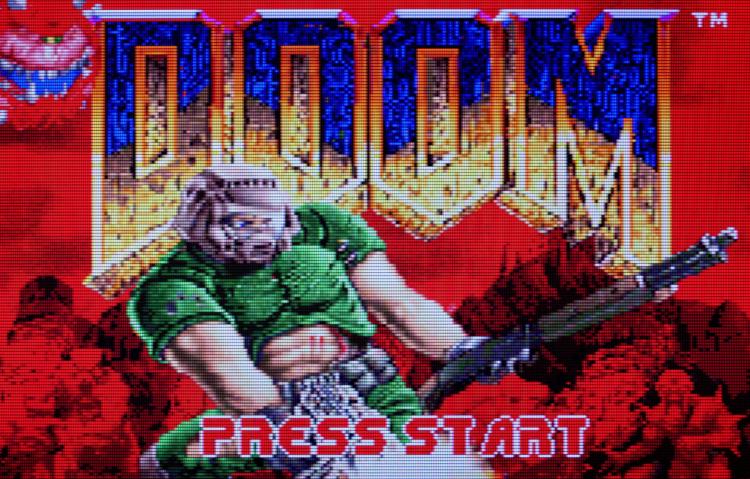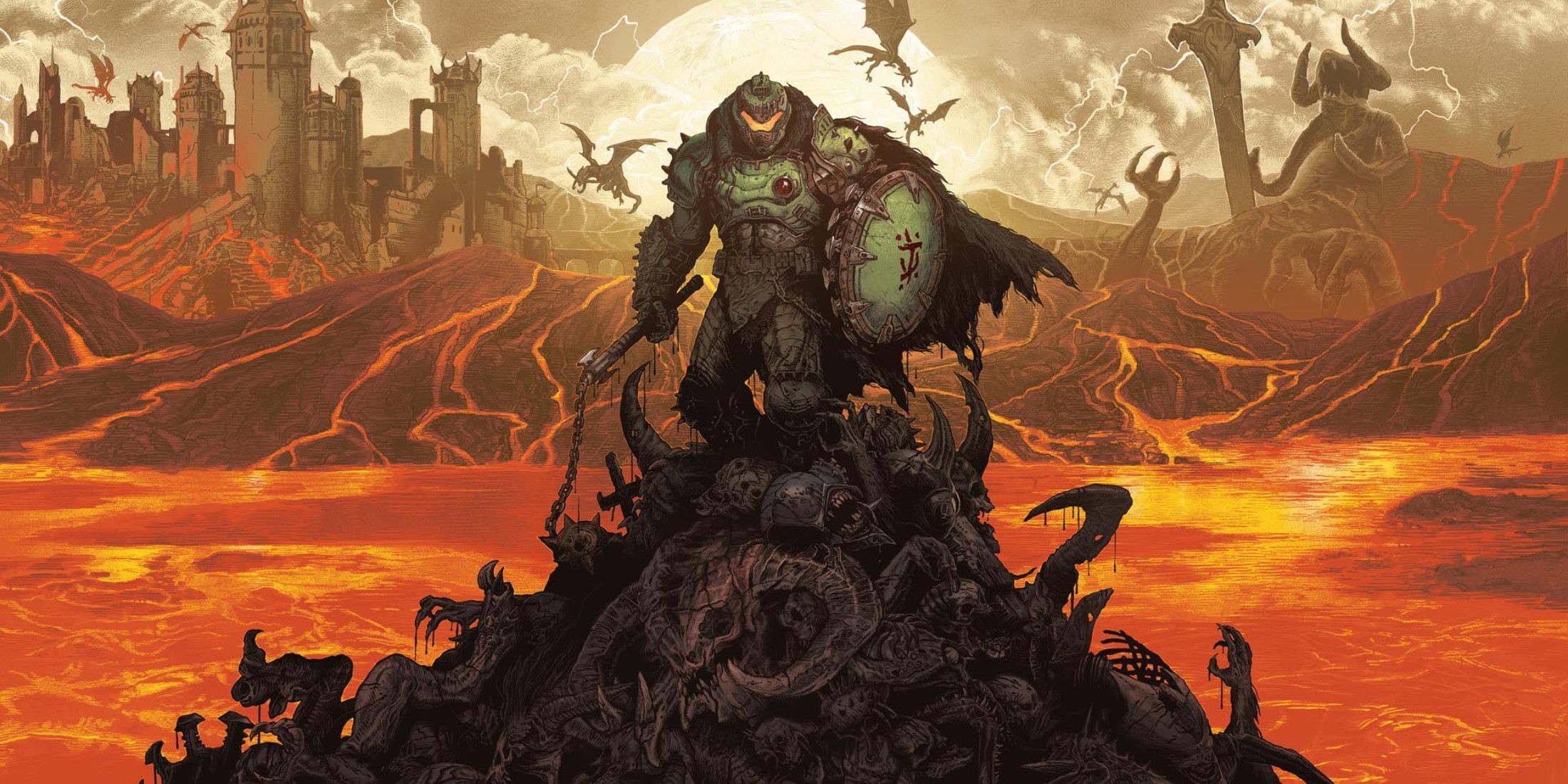A Chronological Journey Through The Doom Games

Table of Contents
Doom (1993): The Genesis of a Legend
Released in 1993, the original Doom was revolutionary. Its groundbreaking 3D graphics, though rudimentary by today's standards, were astonishing at the time. The game's simple yet effective level design, coupled with its bone-jarring sound effects and unforgettable soundtrack by Bobby Prince, created an atmosphere of pure, unadulterated terror. Doom wasn't just about shooting demons; it was about experiencing a visceral, adrenaline-fueled descent into hell. The game's shareware release was a stroke of genius, allowing it to spread rapidly across the nascent internet, solidifying its place in gaming history.
- Groundbreaking 3D graphics for its era. While blocky by modern standards, the visuals were a significant leap forward for the time.
- Iconic weapons like the shotgun and chainsaw. These weapons became instantly recognizable symbols of the franchise.
- Memorable soundtrack by Bobby Prince. The music perfectly complemented the game's atmosphere, enhancing the feeling of dread and chaos.
- Multiplayer deathmatch capabilities. This feature cemented Doom's place as a pioneer of online multiplayer gaming.
Doom II: Hell on Earth (1994): Expanding the Inferno
Building on the success of its predecessor, Doom II: Hell on Earth expanded on nearly every aspect. The improved graphics, more varied level design, and the introduction of new weapons like the Super Shotgun and rocket launcher heightened the intensity. The addition of new enemies, such as the terrifying Arch-Vile, added another layer of challenge. Doom II refined the formula of its predecessor, delivering a more polished and terrifying experience while maintaining the frenetic, fast-paced action that made the original a classic. The multiplayer mode continued to thrive, solidifying its legacy as a cornerstone of competitive gaming.
- New weapons like the Super Shotgun and rocket launcher. These additions provided players with more tactical options in combat.
- More challenging and varied level design. The levels were larger, more complex, and offered more strategic opportunities.
- Introduction of new enemy types, like the Arch-Vile. These powerful demons significantly increased the difficulty.
- Enhanced multiplayer experience. Doom II’s multiplayer mode became even more popular, cementing its place in gaming history.
Doom 3 (2004): A Darker, More Atmospheric Experience
Doom 3, released in 2004, marked a significant departure from its predecessors. Instead of the fast-paced action of the original Doom games, Doom 3 opted for a darker, more atmospheric approach. The game leaned heavily into survival horror elements, emphasizing suspense and atmosphere over relentless action. The improved graphics and use of lighting and sound design created a genuinely immersive and terrifying experience. While the shift in tone wasn't universally praised, it showcased the franchise's ability to evolve and adapt.
- Shift to a darker, more atmospheric setting. The game's tone was noticeably more serious and suspenseful than its predecessors.
- Improved graphics and visual effects. Doom 3 boasted significantly enhanced visuals compared to its predecessors.
- Emphasis on survival horror elements. The slower pace and focus on resource management set it apart from the original games.
- Introduction of a more detailed storyline. Doom 3 included a narrative focusing on the player character's experiences.
Doom (2016): A Brutal Return to Form
The 2016 Doom reboot was a triumphant return to the series' roots. It recaptured the fast-paced, frenetic gameplay of the originals, while simultaneously introducing modern advancements in graphics, sound design, and combat mechanics. The game’s highly satisfying and brutal combat, combined with its emphasis on player mobility and movement, created a thrilling experience that delighted both longtime fans and newcomers. This reboot proved that classic gameplay could be successfully revitalized for a modern audience.
- Return to the fast-paced, classic Doom gameplay. The game brought back the relentless action that defined the original titles.
- Improved graphics and sound design. The visuals and audio were significantly improved, creating a stunning and immersive experience.
- Highly satisfying and brutal combat. The combat system was refined to deliver immensely satisfying and visceral results.
- A strong emphasis on player mobility and movement. The game encouraged aggressive and tactical movement to gain advantages in combat.
Doom Eternal (2020): A More Challenging, Expansive Experience
Doom Eternal, the sequel to the 2016 reboot, built upon its predecessor's success, adding new layers of depth and complexity. New weapons, movement abilities, and traversal mechanics expanded the already thrilling combat. The increased difficulty and strategic depth of the encounters challenged even veteran players. The expanded lore and story further enriched the overall experience. Doom Eternal successfully proved that the Doom franchise could maintain its innovative edge even after decades.
- New movement abilities and traversal mechanics. These additions added to the frenetic pacing of the combat encounters.
- Increased focus on resource management. Strategic resource allocation became critical for survival in the game's harder challenges.
- More challenging combat encounters. The enemies were more aggressive and required more strategic planning to overcome.
- A richer, more expansive story. The lore was further expanded, providing players with a more complete understanding of the game’s world.
The Enduring Legacy of the Doom Games
From its groundbreaking 1993 release to the fast-paced action of Doom Eternal, the Doom franchise has consistently pushed the boundaries of the FPS genre. The series’ impact on gaming is undeniable, influencing countless other titles and shaping the way we think about action games. Its evolution showcases an ability to adapt and innovate while retaining its core identity – a relentless, exhilarating descent into hell. Dive into the demonic depths and experience the thrill of the Doom games for yourself today! Explore the entire catalog of Doom games now and witness firsthand the legacy of this legendary series.

Featured Posts
-
 Plano Islamic Center Development Under Investigation By Texas Rangers Gov Abbotts Order
May 13, 2025
Plano Islamic Center Development Under Investigation By Texas Rangers Gov Abbotts Order
May 13, 2025 -
 Report Dodgers Prepare Aggressive Bid For Top Mlb Free Agent
May 13, 2025
Report Dodgers Prepare Aggressive Bid For Top Mlb Free Agent
May 13, 2025 -
 Doom Dark Ages Inspiration How Classic Doom Influences Modern Development
May 13, 2025
Doom Dark Ages Inspiration How Classic Doom Influences Modern Development
May 13, 2025 -
 Uni A Roma Srbi E Zakhtev Za Prestanak Targetiranja Roma Od Strane Marinike Tepi
May 13, 2025
Uni A Roma Srbi E Zakhtev Za Prestanak Targetiranja Roma Od Strane Marinike Tepi
May 13, 2025 -
 Indore Sizzles At 40 C Loo Warning Issued
May 13, 2025
Indore Sizzles At 40 C Loo Warning Issued
May 13, 2025
Latest Posts
-
 Ofitsialnoe Razreshenie Rpts Smozhet Osuschestvlyat Religioznuyu Deyatelnost V Myanme
May 13, 2025
Ofitsialnoe Razreshenie Rpts Smozhet Osuschestvlyat Religioznuyu Deyatelnost V Myanme
May 13, 2025 -
 Herthas Struggles A Debate Between Boateng And Kruse
May 13, 2025
Herthas Struggles A Debate Between Boateng And Kruse
May 13, 2025 -
 Rpts I Myanma Novye Vozmozhnosti Dlya Religioznoy Raboty
May 13, 2025
Rpts I Myanma Novye Vozmozhnosti Dlya Religioznoy Raboty
May 13, 2025 -
 Boateng And Kruse Clash Over Hertha Berlins Poor Form
May 13, 2025
Boateng And Kruse Clash Over Hertha Berlins Poor Form
May 13, 2025 -
 Hertha Bscs Woes Boateng And Kruses Differing Perspectives
May 13, 2025
Hertha Bscs Woes Boateng And Kruses Differing Perspectives
May 13, 2025
